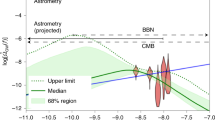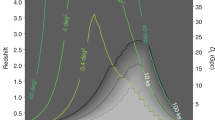Abstract
The direct measurement of gravitational waves is a powerful tool for surveying the population of black holes across the universe. While LIGO has detected black holes as heavy as ~50 M⊙ (ref. 1), there is not yet unambiguous evidence of black holes in the intermediate mass range of 102–5 M⊙. Recent electromagnetic observations have hinted towards the existence of intermediate-mass black holes (IMBHs)2,3,4; however, their masses remain poorly constrained. Here we argue that multiband observations by space- and ground-based gravitational wave detectors5,6 will be able to survey a broad population of IMBHs at cosmological distances. By utilizing general relativistic simulations of merging black holes7 and state-of-the-art gravitational waveform models8, we classify three distinct populations of binaries with IMBHs and discuss what can be observed about each. Multiband observations involving the upgraded LIGO detector9 and the proposed space-mission LISA10 would detect the inspiral, merger and ring-down of IMBH binaries out to redshift ≈ 2, pushing out to redshift ≈ 5 if next-generation ground-based detectors11,12 are operational at the same time. To facilitate studies of multiband IMBH sources, we provide analytic relations for the maximum redshift of multiband detectability, as a function of black hole mass, for various detector combinations. Our study paves the way for future work on what can be learned from IMBH observations in the era of multiband gravitational wave astronomy.
This is a preview of subscription content, access via your institution
Access options
Access Nature and 54 other Nature Portfolio journals
Get Nature+, our best-value online-access subscription
$29.99 / 30 days
cancel any time
Subscribe to this journal
Receive 12 digital issues and online access to articles
$119.00 per year
only $9.92 per issue
Buy this article
- Purchase on Springer Link
- Instant access to full article PDF
Prices may be subject to local taxes which are calculated during checkout




Similar content being viewed by others
Data availability
The data products that support the findings of this study are available via Zenodo at https://doi.org/10.5281/zenodo.3364249.
Code availability
The scripts that support the findings of this study are available via Zenodo at https://doi.org/10.5281/zenodo.3364249.
References
Abbott, B. P. et al. (LIGO Scientific Collaboration and Virgo Collaboration) GWTC-1: a gravitational-wave transient catalog of compact binary mergers observed by LIGO and virgo during the first and second observing runs. Phys. Rev. X 9, 031040 (2019).
Farrell, S. A., Webb, N. A., Barret, D., Godet, O. & Rodrigues, J. M. An intermediate-mass black hole of over 500 solar masses in the galaxy ESO243-49. Nature 460, 73–75 (2009).
Pasham, D. R., Strohmayer, T. E. & Mushotzky, R. F. A 400-solar-mass black hole in the galaxy M82. Nature 513, 74–76 (2014).
Kızıltan, B., Baumgardt, H. & Loeb, A. An intermediate-mass black hole in the centre of the globular cluster 47 Tucanae. Nature 542, 203–205 (2017).
Sesana, A. Prospects for multiband gravitational-wave astronomy after GW150914. Phys. Rev. Lett. 116, 231102 (2016).
Cutler, C. et al. What we can learn from multi-band observations of black hole binaries. Preprint at https://arxiv.org/abs/1903.04069 (2019).
Jani, K. et al. Georgia tech catalog of gravitational waveforms. Class. Quant. Grav. 33, 204001 (2016).
London, L. et al. First higher-multipole model of gravitational waves from spinning and coalescing black-hole binaries. Phys. Rev. Lett. 120, 161102 (2018).
LSC Instrument Science White Paper 2018 (LIGO Scientific Collaboration, 2018); https://dcc.ligo.org/LIGO-T1800133/public
Amaro-Seoane, P. et al. Laser interferometer space antenna. Preprint at https://arxiv.org/abs/1702.00786 (2017).
Punturo, M. et al. The Einstein telescope: a third-generation gravitational wave observatory. Class. Quant. Grav. 27, 194002 (2010).
Reitze, D. et al. Cosmic explorer: the U.S. Contribution to gravitational-wave astronomy beyond LIGO. Preprint at https://arxiv.org/abs/1907.04833 (2019).
LIGO Scientific Collaboration, Virgo Collaboration, Salemi, F. & Papa, M. A. Search for intermediate mass black hole binaries in the first and second observing runs of the advanced LIGO and Virgo network. Preprint at https://arxiv.org/abs/1906.08000 (2019).
LIGO Scientific Collaboration & Virgo Collaboration. Prospects for observing and localizing gravitational-wave transients with advanced LIGO, advanced Virgo and KAGRA. Living Rev. Relativ. 21, 3 (2018).
Lacour, S. et al. Sage: finding IMBH in the black hole desert. Class. Quant. Grav. 36, 195005 (2019).
Cutler, C. & Flanagan, É. E. Gravitational waves from merging compact binaries: How accurately can one extract the binary’s parameters from the inspiral waveform/? Phys. Rev. D 49, 2658–2697 (1994).
Vitale, S. Multiband gravitational-wave astronomy: parameter estimation and tests of general relativity with space- and ground-based detectors. Phys. Rev. Lett. 117, 051102 (2016).
Bellovary, J. et al. Where are the intermediate mass black holes? Preprint at https://arxiv.org.https://arxiv.org/abs/1903.08144
Randall, L. & Xianyu, Z.-Z. A direct probe of mass density near inspiraling binary black holes. Astrophys. J. 878, 75 (2019).
Del Pozzo, W., Sesana, A. & Klein, A. Stellar binary black holes in the LISA band: a new class of standard sirens. Mon. Not. R. Astron. Soc. 475, 3485–3492 (2018).
Madau, P. & Rees, M. J. Massive black holes as population III remnants. Astrophys. J. Lett. 551, L27–L30 (2001).
Calderón Bustillo, J., Salemi, F., Dal Canton, T. & Jani, K. P. Sensitivity of gravitational wave searches to the full signal of intermediate-mass black hole binaries during the first observing run of Advanced LIGO. Phys. Rev. D 97, 024016 (2018).
Tso, R., Gerosa, D. & Chen, Y. Optimizing LIGO with LISA forewarnings to improve black-hole spectroscopy. Phys. Rev. D 99, 124043 (2019).
Haster, C.-J., Antonini, F., Kalogera, V. & Mandel, I. N-body dynamics of intermediate mass-ratio inspirals in star clusters. Astrophys. J. 832, 192 (2016).
Portegies Zwart, S. F., Baumgardt, H., Hut, P., Makino, J. & McMillan, S. L. W. Formation of massive black holes through runaway collisions in dense young star clusters. Nature 428, 724–726 (2004).
Gerosa, D. & Berti, E. Escape speed of stellar clusters from multiple-generation black-hole mergers in the upper mass gap. Phys. Rev. D 100, 041301 (2019).
Wong, K. W. K., Kovetz, E. D., Cutler, C. & Berti, E. Expanding the LISA Horizon from the Ground. Phys. Rev. Lett. 121, 251102 (2018).
Planck Collaboration et al. Planck 2018 results. VI. Cosmological parameters. Preprint at https://arxiv.abs.org/abs/1807.06209 (2018).
Robson, T., Cornish, N. J. & Liu, C. The construction and use of LISA sensitivity curves. Class. Quant. Grav. 36, 105011 (2019).
Moore, C. J., Cole, R. H. & Berry, C. P. L. Gravitational-wave sensitivity curves. Class. Quant. Grav. 32, 015014 (2015).
Acknowledgements
We thank L. Cadonati and C. Berry for useful discussions, and L. London and S. Khan for the links to generate their waveform model in the LIGO Analysis Library. K.J. and D.S. were funded by NASA grant no. 80NSSC19K0322 and NSF grant nos PHY 1806580 and 1809572. The work by C.C. was carried out at the Jet Propulsion Laboratory, California Institute of Technology, under contract to NASA. C.C. also acknowledges support from NSF grant no. PHY-1708212.
Author information
Authors and Affiliations
Contributions
All authors contributed equally to the text and the primary results.
Corresponding author
Ethics declarations
Competing interests
The authors declare no competing interests.
Additional information
Publisher’s note Springer Nature remains neutral with regard to jurisdictional claims in published maps and institutional affiliations.
Supplementary information
Supplementary Information
Supplementary Figs. 1 and 2 and refs. 1–7.
Rights and permissions
About this article
Cite this article
Jani, K., Shoemaker, D. & Cutler, C. Detectability of intermediate-mass black holes in multiband gravitational wave astronomy. Nat Astron 4, 260–265 (2020). https://doi.org/10.1038/s41550-019-0932-7
Received:
Accepted:
Published:
Issue Date:
DOI: https://doi.org/10.1038/s41550-019-0932-7
This article is cited by
-
Computational methods for collisional stellar systems
Living Reviews in Computational Astrophysics (2023)
-
Lunar Gravitational-Wave Detection
Space Science Reviews (2023)
-
Astrophysics with the Laser Interferometer Space Antenna
Living Reviews in Relativity (2023)
-
Cosmology with the Laser Interferometer Space Antenna
Living Reviews in Relativity (2023)
-
The missing link in gravitational-wave astronomy
Experimental Astronomy (2021)



